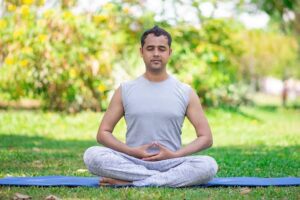Have you ever tried to form a new habit or learn a new skill? You probably realized early on that daily practice was essential for success. That is also true for meditation.
“It’s important to meditate every day because you’re developing a habit,” says Sadie Bingham, a clinical social worker in Gig Harbor, Washington who specializes in anxiety. She is also a long-time meditator.
“Most people won’t notice the positive effects right away, so you’ll need a daily (ish) practice to start seeing the results,” she adds. Starting a daily meditation practice can be difficult, but most people find it easier once they begin to notice some of the numerous benefits.
Still unsure about incorporating meditation into your daily routine? It is entirely possible, and these seven success tips can assist.
Begin small.
While daily meditation is a wonderful goal, you don’t have to start with 30 minutes (or longer) every day.
You may not feel particularly mindful or calm at first. You might not feel at all at ease. But that’s fine. Simply set a timer for five minutes to sit with your thoughts. Be interested in them, but don’t push it.
“Eventually,” Bingham says, “you’ll feel compelled to sit and meditate.”
Don’t worry if you can’t commit to 30 minutes of meditation per day; even 10 or 15 minutes a day can help.
Find the best time.
Different sources will recommend different “ideal” times to meditate. However, your ideal time is whenever you can make meditation work for you.
If you force yourself to meditate at a time that conflicts with your schedule and responsibilities, you’ll likely become frustrated and unmotivated to continue.
Instead, experiment with different meditation times to see what works best for you. That could be first thing in the morning, right before bed, during a hectic commute, or during lunch break at work.
Try to stick to whatever time you choose. Consistency can help your new habit become ingrained in your daily routine.
Be comfortable
You’ve probably seen photos of people meditating in the traditional lotus position. However, that position is not comfortable for everyone, and it is difficult to meditate if you are physically uncomfortable.
Fortunately, you don’t have to get into a specific position to meditate successfully. Instead, simply find a position that you can hold, one that feels comfortable and natural. Both sitting and lying down is acceptable.
If you find it difficult to sit still, try meditating while walking or standing. Some people find that focusing on each step, like focusing on their breath, helps them progress through the meditative process.
Consider creating a relaxing meditation space, or even creating a ritual around the process. Candles, soothing music, and photos and mementos of loved ones can all help to improve meditation.
“The benefits of the ritual are also important,” Bingham says, “because the process becomes a statement that your wellness matters.”
Consider using a meditation app or podcast.
Still, have questions about how you’re supposed to meditate?
If in doubt, consult your smartphone. Meditation isn’t the only thing that has an app for it these days.
Many free apps can get you started with guided meditations, which Bingham recommends for beginners. “A guided meditation can assist in bringing the active mind back to the present moment,” she says.
Apps can also be used to gain access to:
• Meditations for various situations
• Soothing sounds
• Exercising your lungs
• Podcasts
• Tools and graphics for learning more about meditation
• You can also customize the app to track your progress and change your meditation approach based on your current mental state.
• Calm, Headspace, and Ten Percent Happier are some popular apps.
Continue your efforts.
It takes time to form a new habit, so don’t be discouraged if meditation doesn’t seem to work for you right away.
Rather than looking for reasons why you can’t keep going, investigate any difficulties you’re experiencing with curiosity and an open mind. The difficulties you encounter while meditating can point you in the right direction.
If you are easily distracted, consider why. Do you feel uneasy? Tired? Bored? Accept these emotions and make changes as needed—they’re providing you with valuable information. Try meditating in a different position or earlier in the day.
Bingham explains how practicing acceptance and curiosity in meditation can help you translate these feelings more easily into your daily life.
This can make it easier to cultivate awareness regularly
Consider this: If you begin meditating when you are anxious or upset, you may feel a little better. However, if you maintain a regular meditation practice, you may find it easier to manage your stress before your emotions overwhelm you.
Recognize when something isn’t working.
Meditation’s benefits may not be apparent right away. That is perfectly normal. And no matter how long you’ve been practicing, your mind will inevitably wander. That is also normal.
None of this implies that you cannot succeed with meditation. Recognizing when your mind has wandered is a sign that you’re growing in awareness. When this happens, simply gently refocus yourself. With consistent meditation practice, you should begin to see results in a short period
However, it is critical to recognize when meditation causes more harm than good. Although meditation helps many people relieve mental health symptoms, not everyone finds it beneficial, even with regular practice.
Although it is not very common, some people do report trusted Sources increased feelings of depression, anxiety, or panic. If meditation consistently makes you feel worse, you should consult with a therapist before continuing.
Begin now
Are you ready to give daily meditation a try?
To get you started, here’s a simple meditation:
• Find a comfortable place to sit and relax.
• Set a three- to the five-minute timer.
• Begin by concentrating on your breathing. Take note of how each inhales and exhales feels. Breathe slowly and deeply, as if it were natural.
• When your thoughts begin to wander, acknowledge them, let them go, and return your attention to your breathing. Don’t be concerned if this continues; it will.
• Open your eyes when your time is up. Take note of your surroundings, your body, and your emotions. You may or may not feel any different. However, you will most likely notice yourself becoming more aware of your own experience as well as your surroundings over time. These sensations linger long after you have finished meditating.
Are you ready for a change? Try a body scan or learn about the various types of meditation.
In conclusion
There is no correct or incorrect way to meditate. You’ll have the most success if you practice in a way that suits you, so don’t be afraid to experiment with different methods until you find one that works for you.
You’ll know it’s working when you notice more compassion, peace, joy, and acceptance in your life. Just be patient, because these advantages are unlikely to appear overnight. Remember to show up for yourself with curiosity and an open mind, and you’ll be fine.






